Dr.Teruo Higa’s
Living A Dream
- 2025
- Sep:#209 The Widespread Use of EM in Ecuador
- Sep:#208 The Widespread Use of EM in Chile
- Jul:#207 Peru, where EM has taken root throughout the country
- May:#206 EM Application Technology in Paraguay Begins to Evolve into Advanced Circular Agriculture
- May:#205 Practical Application of Soil Disinfectant-Free Cultivation Using EM Technology
- Apr:#204 How EM Use Has Spread Throughout the Philippines
- Mar:#203 How to Use EM to Fundamentally Solve the Problem of Agricultural Residue Burning
- Feb:#202 The Spread of EM technology in Germany
- Jan:#201 The 2nd Ichiro Masaki Memorial Universal Village EM International Conference
- Jan:#200 Cleanup of the Ala Wai Canal in Hawaii, where social bonds are strengthened using EM
- 2024
- Nov:#199 EM trials in India with bananas, tomatoes, and pomegranates
- Oct:#198 The Steadily Evolving EM Nature Farming Method at the Blue Sky Palace - Part 8
- Sep:#197 The Steadily Evolving EM Nature Farming Method at the Blue Sky Palace - Part 7
- Aug:#196 The Steadily Evolving EM Nature Farming Method at the Blue Sky Palace - Part 6
- Jul:#195 The Steadily Evolving EM Nature Farming Method at the Blue Sky Palace - Part 5
- Jun:#194 Steadily Evolving EM Nature Farming Method at the Blue Sky Palace - Part 4
- May:#193 Steadily Evolving EM Nature Farming Method at the Blue Sky Palace - Part 3
- May:#192 Steadily Evolving EM Nature Farming Method at the Blue Sky Palace - Part 2
- Apr:#191 Steadily Evolving EM Nature Farming Method at the Blue Sky Palace
- Mar:#190 Quantum Mechanical Effects of EM Gravitron Charcoal
- Mar:#189 The barrier space in Okinawa (Ryukyu Islands) has risen to another dimension
- Jan:#188 Sixty Days after Typhoon No.6
- 2023
- Oct:#187 Supermassive Typhoon No.6 and Subsequent Typhoon No. 11
- Sep:#186 Massive Typhoon No.6 that swallowed the Ryukyu Islands Graviton barrier
- Sep:#185 August 8th is World “EM Mudball Day”
- Aug:#184 A disease-free life depends on the health of the intestinal microbiome.
- Jul:#183 Trial and Error at the Blue-Sky Palace, Part 3
- Jun:#182 Trial and Error at the Blue-Sky Palace, Part 2
- Apr:#181 Trial and Error at the Blue-Sky Palace
- Mar:#180 Ala Wai Canal Cleanup Project in Waikiki, Hawaii
- Feb:#179 High-Yield, High-Quality Rice Production Using EM
- Feb:#178 The Progress the "Soil Preparation Workshop" of the Oishi 3-chan Club (Part 2)
- Jan:#177 Organic Farming Instructional Manual Using EM
- 2022
- Nov:#176 The Typhoon Situation in Okinawa in 2022
- Sep:#175 Third-Party Verification of the Graviton barrier in Okinawa Part-2
- Sep:#174 Third-Party Verification of the Graviton barrier in Okinawa
- Aug:#173 Ecosystem Changes Observed in Okinawa in 2021 Part-5
- Jun:#172 Ecosystem Changes Observed in Okinawa in 2021 Part-4
- May:#171 Ecosystem Changes Observed in Okinawa in 2021 Part-3
- Apr:#170 Ecosystem Changes Observed in Okinawa in 2021 Part-2
- Mar:#169 Koizumi Farm in Kamakura Continues to Evolve
- Feb:#168 Ecosystem Changes Observed in Okinawa in 2021 Part-1
- 2021
- Dec:#167 Enjoying EM Technology While Enriching the Local Ecosystem
- Nov:#166 A Case Study of the Use of EM in a Next Generation Free School in Tune with the Cycles of Nature
- Oct:#165 Typhoon conditions and flowers in Okinawa from August to October
- Sep:#164 Re-learning the origins of river purification using EM Cleaning up the Dairyuji River in Senami (Murakami City, Niigata Prefecture)
- Aug:#163 Measures Against Natural Disasters and Re-learning the Starting Point of EM
- Jul:#162 Summary of FFC (Foods for Children) Okinawa Forum 2021
- Jun:#161 Restoring the Vigor of an Old Tree and Purifying the Environment with EM Technology That Even an Amateur Can Do
- May:#160 The Public is Beginning to Recognize the Use of EM Smokeless Carbonizers
- Apr:#159 EM Hado (EM Graviton) that exerts quantum superposition effect over time
- Mar:#158 Virus-free Okinawan Plants Through Use of an EM Graviton Barrier
- Jan:#157 Enjoyable Farming for Self-Sufficiency that Even Amateurs Can Do
- 2020
- Dec:#156 EM quantum energy effect occurring in Okinawa
- Nov:#155 Implementing EM graviton farming as a flood countermeasure for apple orchards
- Oct:#154 The Latest Book on the Practical Uses of EM "You Are the One Who Draws Out the Power of Microorganisms," by Chizuko Nomoto
- Sep:#153 Application of EM technology to long periods of rain, lack of sunshine, storms, heavy rains, etc.
- Aug:#152 EM application in Kitanakagusuku village plant waste recycling yard
- Jul:#151 Natural Disaster Countermeasures Using EM Technology: Part 2
- Jul:#150 Natural Disaster Countermeasures Using EM Technology
- May:#149 How to make your home and workplace an energy spot by living a complete EM lifestyle: creating the ultimate source of health and environmental purification
- Apr:#148 EM, Viruses and the Pandemic
- Apr:#147 New agriculture applying quantum mechanics Part 2
- Apr:#146 New agriculture applying quantum mechanics
- Apr:#145 Wonderful EM Miracle
- 2019
- Nov:#144 The movie “Revival II” and the reality of Fukushima
- Oct:#143 Boundary dome and foliar spraying of EM・X GOLD and EM 3
- Oct:#142 Kirakira (Sparkling) Summer Vegetable Festa in 2019
- Aug:#141 Excessive salt inevitably causes salt damage
- Jul:#140 Diverse applications of charcoal Part 3
- Jun:#139 Diverse applications of charcoal Part 2
- Jun:#138 Diverse applications of charcoal
- Jun:#137 Purification power of salt
- May:#136 The degree of soil contamination is a reflection of the microflora
- May:#135 Definitive use of EM barriers to deal with typhoons
- May:#134 Implementing authentic Nature Farming
- May:#133 How to enhance healthy Hado (wave energy) by EM
- May:#132 Eating Dirt (Soil)
- May:#131 Hado (Wave energy) involved in health
- May:#130 Reaffirming EM technology to realize the essence of agriculture
- May:#129 The 2nd EM Producer Networking Meeting
- Apr:#128 Understanding the application of seawater and salt in crop cultivation
- Apr:#127 Prevention of Disasters by EM Technology
- Mar:#126 Quantum overlay effective utilization of EM
- Jan:#125 EM Disaster Recovery Support Projects in 2017
- 2018
- 2017
- Aug:#121 Escape from conventional agricultural traps
- Jul:#120 Limitation and important caveats regarding utilization of salt
- Jun:#119 EM Technology to Break Through the Limits of Pesticide-Free Strawberries
- May:#118 Application of barriers using EM rectification force
- Apr:#117 The 1st EM Produce Growers' Networking Conference
- Mar:#116 Sumizo kun: The Ultimate Versatile Carbonization Equipment
- Feb:#115 How to make and use simple carbonized and rectified ash
- Jan:#114 Achievements of 2016
- 2016
- Dec:#113 Definitive Measures Against Typhoons
- Nov:#112 International Conference on Universal Village
- Oct:#111 90% of Your Body is Microbes
- Sep:#110 Disaster Countermeasures Using EM
- Aug:#109: Changes in the Natural Environment by EM Barrier Domes in Okinawa
- Jul:#108: Multi-purpose Utilization of Activated EM with Seawater and Salt
- Jun:#107: Marine Day, when EM Mudballs and Activated EM are Applied Throughout Japan
- May:#106: The Function of EM and Gravitational Waves–Part 3
- Apr:#105: The Function of EM and Gravitational Waves–Part 2
- Feb:#104: The Function of EM and Gravitational Waves
- Feb:#103: The Importance of Phototrophic Bacteria in EM
- 2015
- Dec:#102: Results of Environmental Forum "Utsukushima EM Paradise" 2015
- Nov:#101: Environmental Forum "Utsukushima EM Paradise" 2015
- Oct:#100: A New Phase of Limit Breakthrough Using EM
- Sep:#99: A New Phase of Limit Breakthrough through EM
- Aug:#98: The Tokyo Bay Area Began Creating a Truly Livable Hometown
- Jul:#97: Rectifying Effects of EM
- Jun:#96: Lake Suwa Sousei lecture
- May:#95: In Order to Further Ensure Limit Breakthrough
- Apr:#94: Theatrical Release of the Documentary Film SOSEI-Revival to Enlighten People on the New Possibilities of Microorganisms
- Mar:#93: What Underlies Limit Breakthrough (Part 2)
- Feb:#92: EM Functions to Break Through Limits
- Jan:#91: At the Start of 2015
- 2014
- Dec:#90: Looking Back at 2014
- Nov:#89: Shikoku EM FESTA 2014, Virtuous Circle Conference in Matsuyama, Ehime Prefecture
- Oct:#88: Using EM to Deal with Weather Disasters (Part 2)
- Sep:#87: Current Status of Radioactivity Measures Using EM in Fukushima
- Aug:#86: APNAN (Asia Pacific Natural Agriculture Network) 25th Anniversary Conference in 2014
- Jul:#85: Using EM to Deal with Weather Disasters
- Jun:#84: Substantial Improvement of Soil
- May:#83: The Energy Rectification Force of EM
- Apr:#82: The Annual 18th EM Technology Exchange Meeting and Tohoku Conference in Shichigahama
- Mar:#81: Salmon going upstream in Kitaura (Kasumigaura)
- Feb:#80: The Microbiome Again
- Jan:#79: Inauguration of the Federation of Diet Members Who Use and Apply Effective Microorganisms
- 2013
- Dec:#78: Receiving an Honorary Doctoral Degree from Rajamangala University of Technology in Thailand
- Nov:#77: The Use of EM in School Education in Bhutan
- Oct:#76: Well of Bonding
- Sep:#75: The Background to EM Not Being Employed by Public Institutions to Deal with Radiation
- Aug:#74: Dealing with Disaster: Using EM in Crisis Management
- Jul:#73: EM Events on Ocean Day
- Jun:#72: Using EM to Deal With Heat Stroke and Summer Heat Fatigue
- May:#71: An EM Model Town in Malaysia
- Apr:#70: Steps the Japanese Government is Taking to Deal with Radiation: Are They Really Safe?
- Mar:#69: EM Group Disaster Reconstruction Aid Project in Fukushima
- Feb:#68: EM and Microbiomes (Microbial Flora)
- Jan:#67: A Necessary Evil is Still Evil
- 2012
- Dec:#66: The 17th National EM Technology Exchange Conference / Hokkaido Conference in Sapporo
- Nov:#65: EM Forum 2012 in Okinawa and the Environmental Forum in Fukushima
- Oct:#64: 2012 EM Forum
- Sep:#63: A New Earth Saving Revolution
- Aug:#62: The Asahi Newspaper’s Misguided Reports About EM
- Jul:#61: Using EM in Radioactive Contamination Measures in Fukushima Prefecture
- Jun:#60: The Effects of Using EM to Inhibit the Absorption of Radioactivity as Confirmed in Fukushima
- May:#59: Recovery Support for the Great East Japan Earthquake
- Apr:#58: The Royal Kingdom of Thailand, in which EM Functions as a Set Government Policy
- Mar:#57: Report on the Measures Taken by Kingdom of Thailand Using EM to Deal with Polluted Water
- Feb:#56 EM™ as Part of National Policy in Thailand to Deal with Sanitation Issues Resulting from the Flood of 2011
- Jan:#55 The Law of Syntropy (Revitalization)
- 2011
- Dec:#54 EM Forum 2011
- Nov:#53 Shikoku EM Festa 2011- Zenjunkan no Wa (Virtuous Circle) Tokushima Conference in Naruto -
- Oct:#52 The Mystery of Interim Safety Values for Radioactive Material
- Sep:#51 Successful Radiation Countermeasures Using EM
- Aug:#50 Events on Sea Day in which EM Mud Balls are Thrown into the Water and Activated EM is Applied.
- May:#47 Dealing with the Damage Caused by the Eastern Japan Earthquake
- Apr:#46 Eastern Japan Earthquake
- Mar:#45 The 16th National EM Technology Hokuriku Conference in Fukui
- Feb:#44 More Thoughts on Avian Influenza and Foot-and-Mouth Disease
- Jan:#43 Happy New Year!
- 2010
- Dec:#42 Shikoku EM FESTA 2010・Zenjunkan no wa (Virtuous Circle) Fellowship Conference in Tobe, Ehime Prefecture
- Nov:#41 EM Forum 2010
- Oct:#40: My Thanks to the EM™ Volunteers Who Helped in the Fight Against Foot-and-Mouth Disease in Miyazaki Prefecture
- Sep:#39 International EM Mud Ball Day
- Jul:#37 Poland EM Forum 2010
- Jun:#36 EM Countermeasures Against Foot-and-Mouth Disease
- May:#35 Abnormal Weather
- Apr:#34 EM Activities in Thailand: Finding Solutions to the Challenges Facing the Nation
- Mar:#33 New Developments in the Evolution of EMTM in Thailand
- Feb:#32 Results Starting to Be Seen at the Mikasa Project
- Jan:#31 Towards an EM-Use Society
- 2009
- Dec:#30 EM Summit
- Nov:#29 The System in Penang State in Malaysia that Made the World EMTM Mudball Day a Success
- Oct:#28 The "World EM Mudball Day" in Malaysia
- Sep:#27 Validating EMTM Medicine: Case Study Reports from EM Users 2009. (Part 3)
- Sep:#26 Validating EMTM Medicine: Case Study Reports from EMTM Users 2009. (Part 2)
- Jul:#25 Validating EMTM Medicine: Case Study Reports from EMTM Users 2009. (Part 1)
- Jun:#24 Activities to Disseminate EM-Focused Nature Farming in China
- May:#23 Use of EMTM in Response to Swine Flu
- Apr:#22 Using EM to Solve Public Administrative Costs
- Mar:#21 Reaffirming the Versatility of EM
- Jan:#20 The Beginning of a New Era
- 2008
#159 EM Hado (EM Graviton) that exerts quantum superposition effect over time
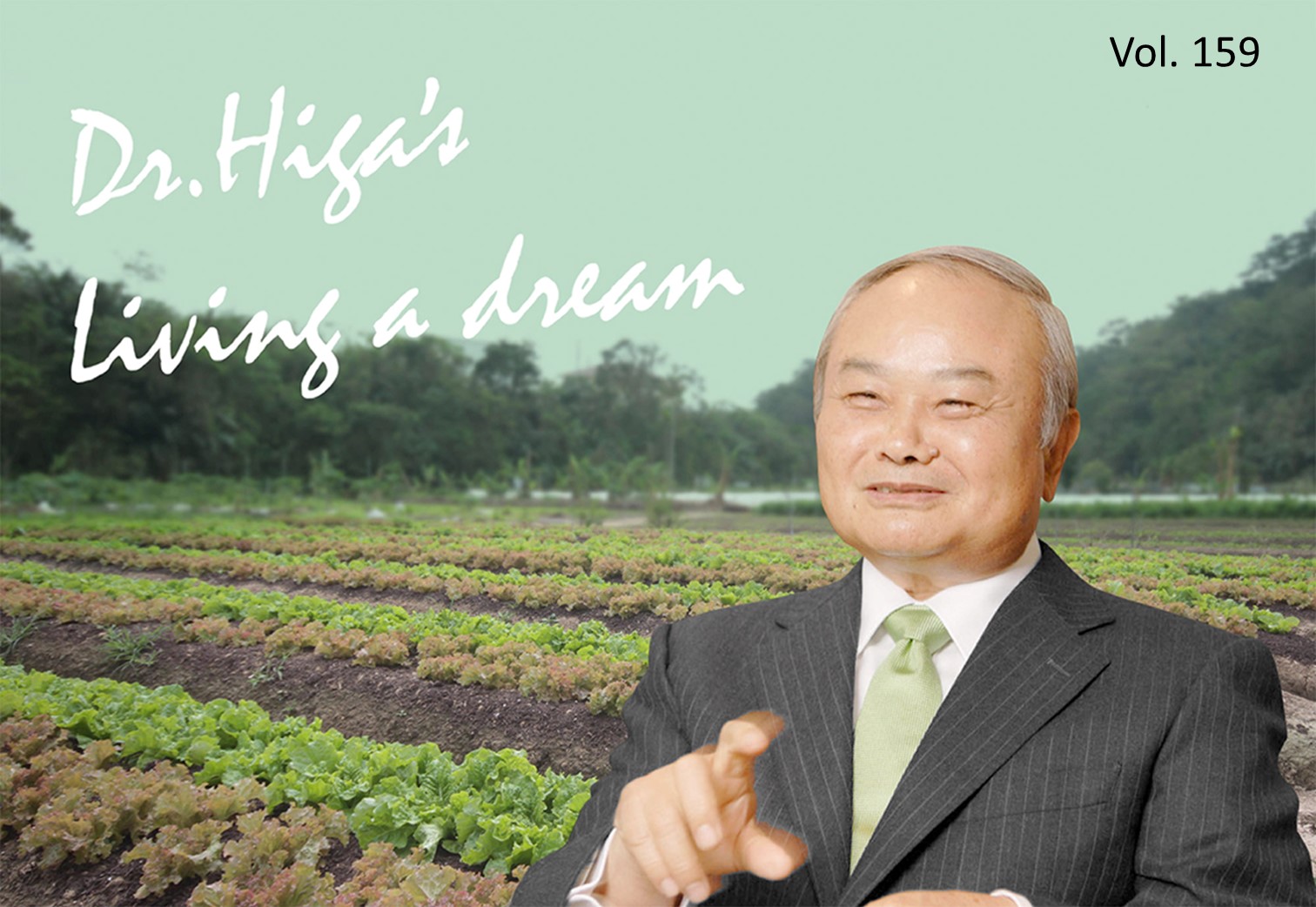
The key to utilizing EM is to continue using it until EM is established in the environment, and when the results begins to appear it can become a self-propagating cycle without the need for additional input for more than 15 years, an example being the dam at the University of the Ryukyus.
Mikawa Bay and Tokyo Bay have reached that level, and the academics and the media who, 10 to 15 years ago, were insisting on the impossibility of recovery, have completely forgotten about how terrible it was in the past and are reporting and featuring the sea as if it had always been clean and rich. Today, rivers with estuaries in bays purified with EM are teeming with ayu (sweetfish), fish and shellfish are increasing, and a rich natural ecosystem has been created.
On February 24, 2021, a local newspaper in Okinawa referred to Triangle Pond in Tomigusuku City as one of the best “waterfowl paradises” in Japan, stating that “it is not clear why the birds have come to this pond,” since “there are other nice, spacious places to rest,” and that “as a resting place the conditions are not so good. (See Photo 2)
The answer is that EM has cleaned the water, and with this there has been an increase in the number of fish and shellfish. In other words, because the system increases the amount of food for the birds, they appear in large quantities. In this area, the EM Research Organization and the Itoman Fisheries Cooperative have been working together for more than ten years to introduce EM Bokashi balls and Activated EM liquid, and the Itoman Fisheries Cooperative officials are also satisfied with the results.
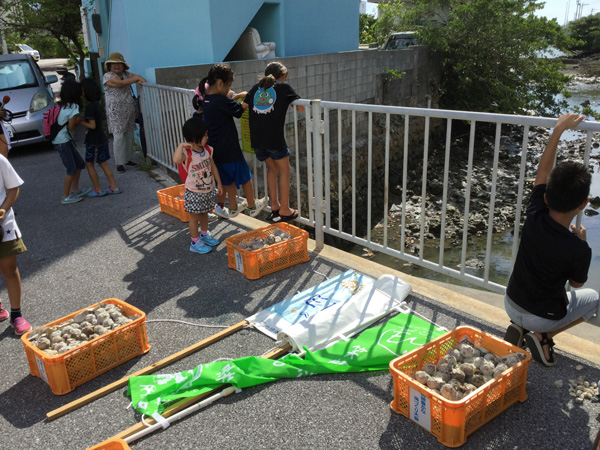
Photo 1: EM Bokashi balls thrown in with the cooperation of the Itoman Fisheries Cooperative Association (2017)
The key to using EM is to apply it at a certain amount of density at the beginning, and when odors disappear and the water starts to become clean, reduce it to smaller amounts applied often, much like an intravenous drip. In other words, if one ton of EM is poured in at one time, it will be extremely effective in spreading EM throughout the entire area, but the Hado level will remain that of a one-time application.
If 1liter each is applied 1000 times, the Hado level will be 1000 times higher, even though it is the same total amount of EM. In other words, the key to making the most effective use of EM is to divide it into smaller portions and repeat the process many times to enhance the quantum layering effect.
This can be achieved not only by wiping and spraying in the home, but also by adding enough sugar to fruit peels fermented with microorganisms and eating them frequently. The sugar will not add any extra calories but will play an effective role in quantum layering to increase the number of good microorganisms such as EM in the intestines, creating a base for all of types immunity.
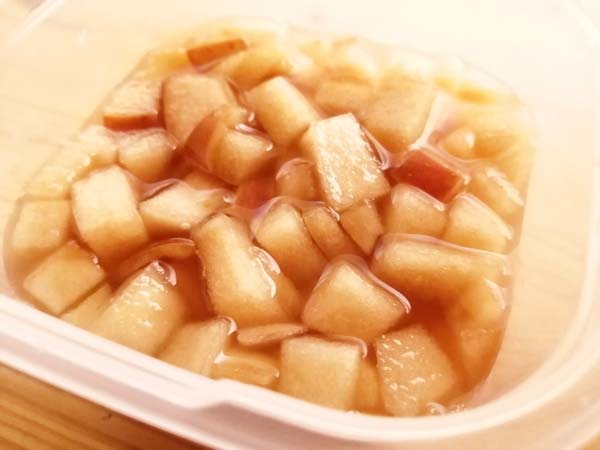
Photo: Apple puree in the fermentation process. It can be made with the fruit as well as the skin.
I have explained the main changes on land, but since November 2013, the sea has gradually become cleaner, and large fish that used to require a boat trip to catch are now commonly found at points along the coast and in fishing ports, adding great interest to the weekly fishing reports. At the same time, there are reports about how fishing ports are booming. (See Photo 3)
Since February the local newspaper (Okinawa Times) has been publishing news about various flowers every day, but such information has been limited so far. (See Photos 4 to 14)
Every day seems to bring new reports on flowers, and people are greatly enjoying how well they are blooming this spring.
Mikawa Bay and Tokyo Bay have reached that level, and the academics and the media who, 10 to 15 years ago, were insisting on the impossibility of recovery, have completely forgotten about how terrible it was in the past and are reporting and featuring the sea as if it had always been clean and rich. Today, rivers with estuaries in bays purified with EM are teeming with ayu (sweetfish), fish and shellfish are increasing, and a rich natural ecosystem has been created.
On February 24, 2021, a local newspaper in Okinawa referred to Triangle Pond in Tomigusuku City as one of the best “waterfowl paradises” in Japan, stating that “it is not clear why the birds have come to this pond,” since “there are other nice, spacious places to rest,” and that “as a resting place the conditions are not so good. (See Photo 2)
The answer is that EM has cleaned the water, and with this there has been an increase in the number of fish and shellfish. In other words, because the system increases the amount of food for the birds, they appear in large quantities. In this area, the EM Research Organization and the Itoman Fisheries Cooperative have been working together for more than ten years to introduce EM Bokashi balls and Activated EM liquid, and the Itoman Fisheries Cooperative officials are also satisfied with the results.

Photo 1: EM Bokashi balls thrown in with the cooperation of the Itoman Fisheries Cooperative Association (2017)
The key to using EM is to apply it at a certain amount of density at the beginning, and when odors disappear and the water starts to become clean, reduce it to smaller amounts applied often, much like an intravenous drip. In other words, if one ton of EM is poured in at one time, it will be extremely effective in spreading EM throughout the entire area, but the Hado level will remain that of a one-time application.
If 1liter each is applied 1000 times, the Hado level will be 1000 times higher, even though it is the same total amount of EM. In other words, the key to making the most effective use of EM is to divide it into smaller portions and repeat the process many times to enhance the quantum layering effect.
This can be achieved not only by wiping and spraying in the home, but also by adding enough sugar to fruit peels fermented with microorganisms and eating them frequently. The sugar will not add any extra calories but will play an effective role in quantum layering to increase the number of good microorganisms such as EM in the intestines, creating a base for all of types immunity.

Photo: Apple puree in the fermentation process. It can be made with the fruit as well as the skin.
I have explained the main changes on land, but since November 2013, the sea has gradually become cleaner, and large fish that used to require a boat trip to catch are now commonly found at points along the coast and in fishing ports, adding great interest to the weekly fishing reports. At the same time, there are reports about how fishing ports are booming. (See Photo 3)
Since February the local newspaper (Okinawa Times) has been publishing news about various flowers every day, but such information has been limited so far. (See Photos 4 to 14)
Every day seems to bring new reports on flowers, and people are greatly enjoying how well they are blooming this spring.
----------------------------------------------------------------------------------------
Photo 2: One of the best “waterfowl paradises” in Japan. 2/24/2021(Courtesy of Okinawa Times)
2/24/2021 Okinawa Times
One of the best “waterfowl paradises” in Japan
Triangle Pond in Tomigusuku
Triangle Pond in Yone, Tomigusuku City, is one of the best places in Japan to observe a wide variety of migratory birds, including the endangered Black-faced Spoonbill.
It is not clear why the birds started coming to this pond. It is noisy because it faces a busy road. The pond is the size of a baseball fair ground, but half of it is overgrown with reeds, and the area where birds gather is only as large as a baseball diamond. The pond is also littered with garbage. From our viewpoint, it does not seem well suited to serve as a resting place for birds. I am tempted to ask the birds whether they wouldn’t be safer and more secure in the nearby Gushi, Lake Manko and Toyosaki Tidal Flats instead of Triangle Pond.
The official name of the Triangle Pond is the First Flood Control Basin. It was completed by the prefecture about 50 years ago for flood control purposes. The small triangle area developed as a manmade pond has become a temporary home for migratory birds flying down from thousands of kilometers away in the north. Masakuni Yamashiro, 58, chairman of the Okinawa Wild Bird Society, pointed out that “We need to manage the environment of the pond.”
Why don’t people make some modifications in order to make the pond a true “paradise for waterfowl”? I propose this as one of those who uses this Triangle Pond as a shooting spot.
(Hiroya Shimoji, Photo Department)
This project introduces current information on what’s happening in Okinawa in photos on the last Wednesday of every month.
Photo captions:
Black-winged stilt with long, thin legs. It is also called a “ballerina of the waterfront” because of its tall, slender appearance. Photo taken on the 18th, at the Triangle Pond in Yone, Tomigusuku City
Black-faced Spoonbill grooming its feathers, January 30
Commonly known as Triangle Pond, in Yone, Tomigusuku City, January 30
Kingfisher hovering in search for fish, January 21
Spot-billed ducks swimming in the clear water, January 30
Water hens splashing as they fight for territory, January 30
A gray heron successfully captures a fish, January 21
-----------------------------------------------------------------------------------

Photo 2: One of the best “waterfowl paradises” in Japan. 2/24/2021(Courtesy of Okinawa Times)
2/24/2021 Okinawa Times
One of the best “waterfowl paradises” in Japan
Triangle Pond in Tomigusuku
Triangle Pond in Yone, Tomigusuku City, is one of the best places in Japan to observe a wide variety of migratory birds, including the endangered Black-faced Spoonbill.
It is not clear why the birds started coming to this pond. It is noisy because it faces a busy road. The pond is the size of a baseball fair ground, but half of it is overgrown with reeds, and the area where birds gather is only as large as a baseball diamond. The pond is also littered with garbage. From our viewpoint, it does not seem well suited to serve as a resting place for birds. I am tempted to ask the birds whether they wouldn’t be safer and more secure in the nearby Gushi, Lake Manko and Toyosaki Tidal Flats instead of Triangle Pond.
The official name of the Triangle Pond is the First Flood Control Basin. It was completed by the prefecture about 50 years ago for flood control purposes. The small triangle area developed as a manmade pond has become a temporary home for migratory birds flying down from thousands of kilometers away in the north. Masakuni Yamashiro, 58, chairman of the Okinawa Wild Bird Society, pointed out that “We need to manage the environment of the pond.”
Why don’t people make some modifications in order to make the pond a true “paradise for waterfowl”? I propose this as one of those who uses this Triangle Pond as a shooting spot.
(Hiroya Shimoji, Photo Department)
This project introduces current information on what’s happening in Okinawa in photos on the last Wednesday of every month.
Photo captions:
Black-winged stilt with long, thin legs. It is also called a “ballerina of the waterfront” because of its tall, slender appearance. Photo taken on the 18th, at the Triangle Pond in Yone, Tomigusuku City
Black-faced Spoonbill grooming its feathers, January 30
Commonly known as Triangle Pond, in Yone, Tomigusuku City, January 30
Kingfisher hovering in search for fish, January 21
Spot-billed ducks swimming in the clear water, January 30
Water hens splashing as they fight for territory, January 30
A gray heron successfully captures a fish, January 21
-----------------------------------------------------------------------------------
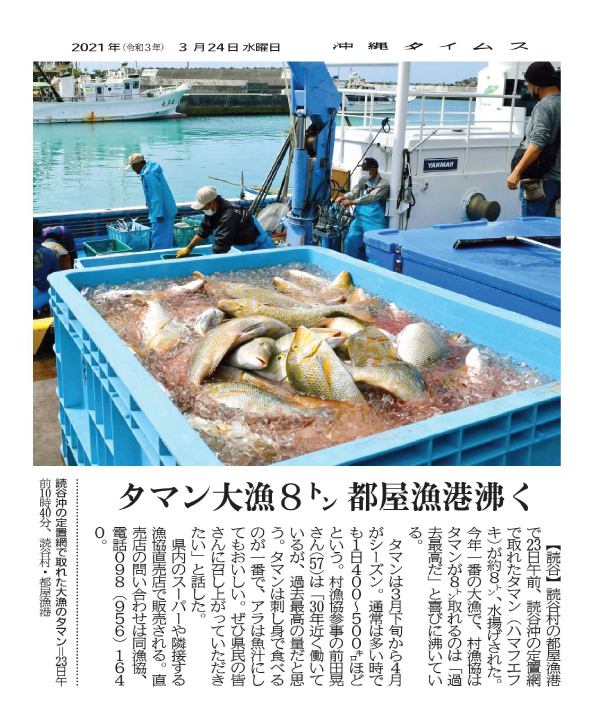
Photo 3: A big catch of Taman (Ornate emperor) 3/24/2021(Courtesy of Okinawa Times)
8 tons of Taman (Ornate emperor) Caught by Yomitan Village Fisheries Cooperative
On the morning of the 23rd, about 8 tons of Taman (Ornate emperor) caught in the fixed nets off the coast of Yomitan were unloaded at Toya Fishing Port in Yomitan Village. It was the biggest catch of the year, and the village fishermen’s cooperative is overjoyed, saying that the catch of eight tons of Taman was the highest ever. The season for Taman is from late March to April. Usually a large catch would be only about 400 to 500 kilograms a day.
Mr. Akira Maeda, 57, a councilor of the village fishery cooperative, said, “I have been working for almost 30 years, but I think this is the highest amount ever. Taman is best eaten as sashimi, and the bony parts are also delicious in fish soup. I hope all the people in the prefecture will enjoy it.”
The fish will be sold at supermarkets in the prefecture and at the direct sales stores of neighboring fishing cooperatives.
For more information, call the fishery cooperative at 098(956)1640.
A big catch of Taman (Ornate emperor) caught in a fixed net off Yomitan, 10:40am, March 23, Toya Fishing Port, Yomitan Village
3/24/2021(Courtesy of Okinawa Times)
----------------------------------------------------------------------------------------
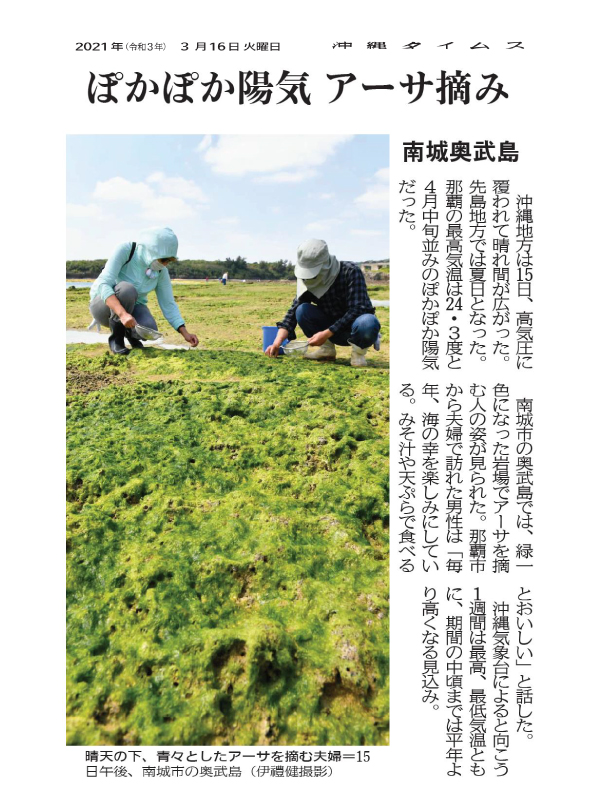
Photo 4: A warm and sunny day for picking Sea Lettuce 3/16/2021(Courtesy of Okinawa Times)
A warm and sunny day for picking Sea Lettuce
Oujima, Nanjo City
On the 15th, the Okinawa region was covered by high pressure, and sunny skies prevailed. It was a hot summer day in the Sakishima area. The highest temperature in Naha was 24.3℃, which made it as warm and sunny as mid-April. On Oujima, Nanjo City, Okinawa Prefecture, people could be found picking sea lettuce on the rocky beach that was entirely green. One man and his wife from Naha City said, “We look forward to the sea lettuce every year. It is delicious in miso soup or as deep-fried crispy tempura.”
According to the Okinawa Meteorological Observatory, both maximum and minimum temperatures are expected to be higher than normal next week until about the middle of the week.
A couple picking lush sea lettuce under the clear sky Oujima in Nanjo City on the afternoon of the 15th.
3/16/2021 (Courtesy of Okinawa Times)
----------------------------------------------------------------------------------------
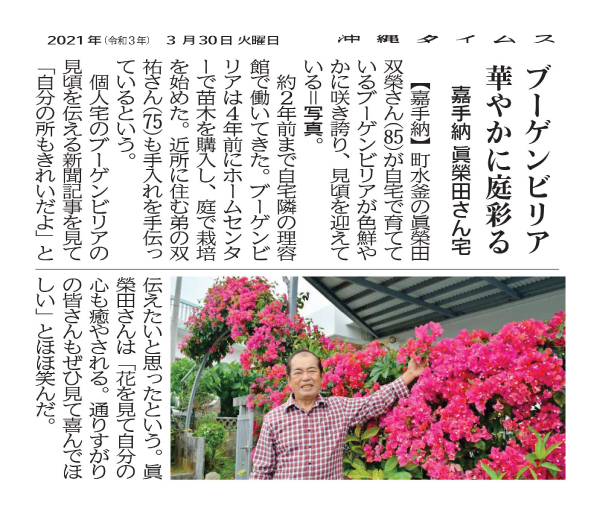 Photo 5: Bougainvillea gorgeously adorns the garden 3/30/2021(Courtesy of Okinawa Times)
Photo 5: Bougainvillea gorgeously adorns the garden 3/30/2021(Courtesy of Okinawa Times) Bougainvillea gorgeously adorns the garden at Mt. Maeda’s home in Kadena
The bougainvillea that Mr. Souei Maeda, 85, of Mizugama, Kadena Town grows at his home is in full bloom with vivid colors. Right now is the best time to appreciate it. He worked at a barbershop next to his house until about two years ago. Four years ago, he bought a bougainvillea seedling at a home improvement center and started growing them in his garden. His younger brother, Sosuke, 75, who lives nearby, also helps him taking care of them.
When he saw a newspaper article about bougainvillea at a private home, he wanted to tell people that his bougainvillea were blooming beautifully, too. Mr. Maeda said, with a smile, “Seeing the flowers is so soothing. I hope that everyone passing by will enjoy seeing them, too.”
3/30/2021 (Courtesy of Okinawa Times)
----------------------------------------------------------------------------------------
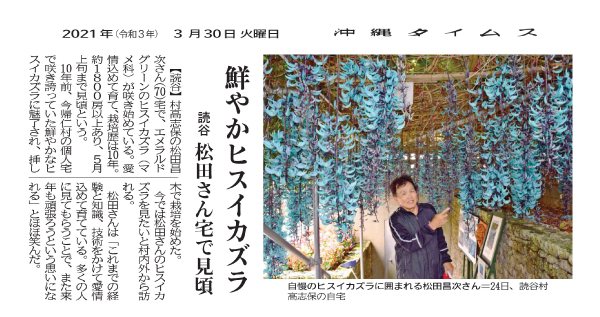
Photo 6: Vivid jade vine 3/30/2021(Courtesy of Okinawa Times)
Vivid jade vine in full bloom at Mr. Matsuda’s house in Yomitan
At the home of Mr. Masaji Matsuda, 70, in Takashiho, Yomitan village, emerald green jade vines (Fabaceae) are beginning to bloom. He has been lovingly growing them ten years. There are more than 1,800 bunches, and they will be in full bloom until early May.
Ten years ago, Mr. Matsuda was fascinated by the brilliant color jade vine blooming at a private home in Nakijin Village, and started cultivating it from cuttings. Now, people from the village and elsewhere come to see Mr. Matsuda’s jade vines. “I grow them with love,” he said with a smile, “using my experience, a fatherly style, and my skill. Having so many people see them gives me the motivation to do my best again next year.”
Mr. Matsuda, surrounded by his pride and joy, the jade vine, 24th, at his home in Takashiho, Yomitan Village
3/30/2021(Courtesy of Okinawa Times)
----------------------------------------------------------------------------------------
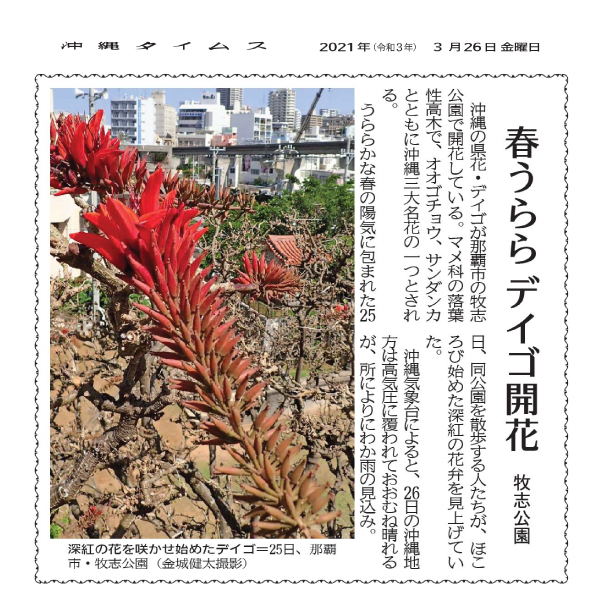
Photo 7: Deigo (Erythrina variegate ) in bloom 3/26/2021(Courtesy of Okinawa Times)
A lovely spring and Deigo (Erythrina variegate ) in bloom at Makishi Park
Okinawa’s prefectural flower, Deigo, is in bloom at Makishi Park in Naha City. It is a deciduous tree of the Fabaceae family and is considered to be one of the three major flowers of Okinawa along with the Peacock Flower and Chinese Ixsora. On the 25th, when the sun was shining brightly, people strolling in the park looked up at the deep red petals that were beginning to blossom.
According to the Okinawa Meteorological Observatory, the weather in Okinawa on the 26th will be mostly sunny with high pressure, but showers are expected in some places.
The deep red flowers of Deigo have begun to bloom.
Makishi park, Naha City, on March 25 (Photo by Kenta Kinjo)
3/26/2021(Courtesy of Okinawa Times)
----------------------------------------------------------------------------------------
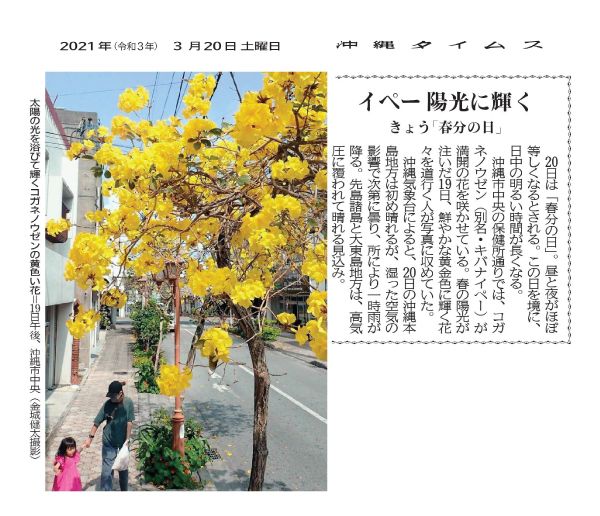
Photo 8: Ipe-amarelo, shining in the sun 3/20/2021(Courtesy of Okinawa Times)
Ipe-amarelo, shining in the sun
Today is the Vernal Equinox
March 20th is the Vernal Equinox, when day and night are of equal length. After this day, the daylight hours become longer. On the street where the public health center is in the center of Okinawa City, a Golden trumpet tree (also known as Kinbana Ipe) is in full bloom. On the 19th, when the spring sunlight was pouring in, passersby were taking pictures of the bright golden flowers.
According to the Okinawa Meteorological Observatory, the Okinawa region on the 20th will be sunny at first, but it will gradually become cloudy due to the influence of moist air, and there will be periods of rain in some places. The Sakishima Islands and the Daito Islands area are expected to be covered by a high pressure system and will be clear.
The yellow flowers of Golden Trumpet tree shining in the sunlight.
Central Naha City on the afternoon of March 19 (Photo by Kenta Kinjo)
3/20/2021(Courtesy of Okinawa Times)
----------------------------------------------------------------------------------------
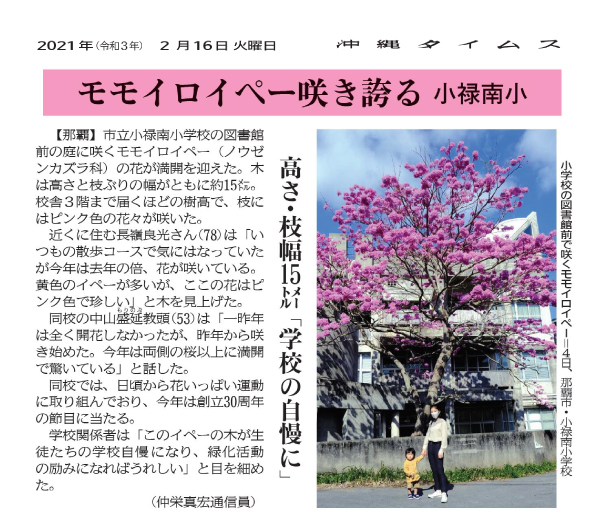 Photo 9: Ipe-rosa in full bloom 2/16/2021(Courtesy of Okinawa Times)
Photo 9: Ipe-rosa in full bloom 2/16/2021(Courtesy of Okinawa Times)Ipe-rosa in full bloom, Orokuminami Elementary School boasts 15-meter high and 15-meter wide branches—the pride of the school
February 16, 2021
The Ipe-rosa flowers blooming in the garden in front of the library at Naha Municipal Orokuminami Elementary School are in full bloom. The height of the tree and the width of the branches are both about 15 meters. The tree is tall enough to reach the third floor of the school building, and its branches are covered with pink flowers.
Mr. Yoshimitsu Nagamine, 78, who lives nearby said, “I have worried about the tree since I see it on my usual walking course, but this year the flowers are blooming twice as much as last year. There are many yellow Ipe, but this one is pink, which is unusual,” he said, looking up at the tree.
Vice-principal Morinobu Nakayama, 53, of the school said, “It didn’t bloom at all two years ago, but it started to bloom last year. This year, I am surprised that it is in full bloom more than the cherry blossoms on both sides of it.” The school is involved in a nationwide municipal campaign to encourage people to plant flowers, and this year marks the 30th anniversary of the school’s founding. A school official said, “I would be very pleased if this Ipe-rosa tree makes our students even prouder of our school and encourages them in their greening activities.”
Photo caption:
Ipe-rosa blooming in front of the elementary school library, on the 4th, Naha City, Orokuminami Elementary School
Hiroshi Nakaema, Reporter
2/16/2021(Courtesy of Okinawa Times)
----------------------------------------------------------------------------------------
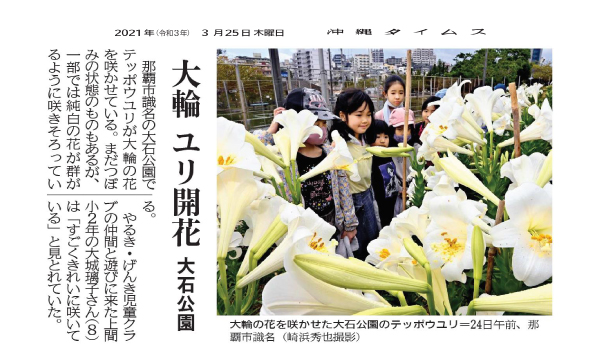
Photo 10: Large-flowered lilies in bloom 3/25/2021(Courtesy of Okinawa Times)
Large-flowered lilies in bloom
Ooishi Park
The Easter lilies are in full bloom at Oishi Park in Shikina, Naha City. Some of them are still in buds, but some are blooming in clusters of pure white flowers. Riko Oshiro (8), a second grader at Kamima Elementary School, who came to visit with her friends from the Yaruki Genki* Children’s Club said, “They’re so beautiful!”
Easter Lilies in Oishi Park with large flowers
In the morning, March 24, Shikina, Naha City
(Photo by Hideya Sakihama)
3/25/2021(Courtesy of Okinawa Times)
(*Yaruki=motivation; Genki=Energetic, so the name means something like “Rarin’ to Go--Let’s Do It!”)
----------------------------------------------------------------------------------------
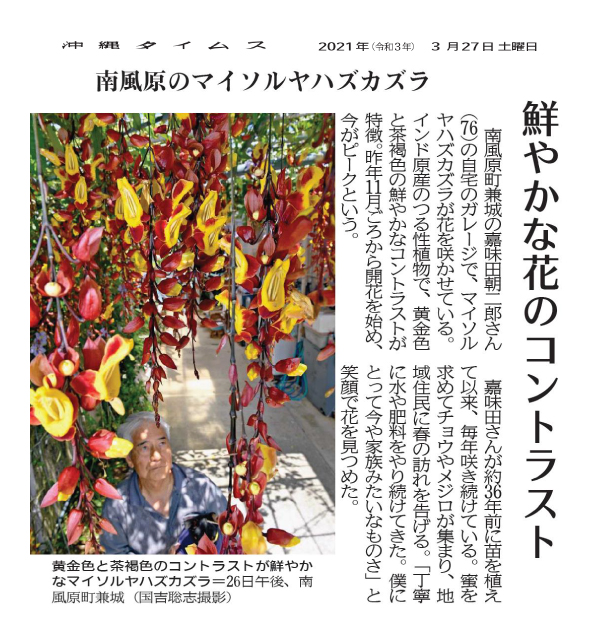
Photo 11: A contrast of brilliantly colored flowers 3/27/2021(Courtesy of Okinawa Times)
A Contrast of Brilliantly Colored Flowers
Indian Clock Vine (Thunbergia Mysorensis) in Haebaru Town
In the garage of Mr. Asajiro Kamida, 76, of Kanegusuku, Haebaru Town, an Indian Clock Vine is in full bloom. This vine, native to India, features a vivid contrast of golden and brown colors.
It started blooming around November last year, and is at its peak now. The vine has continued to bloom every year since Mr. Kamida planted the seedlings about thirty-six years ago. Butterflies and white-eyes gather in search of berries, announcing the arrival of spring to the local residents. “I’ve been carefully watering and fertilizing it, and it’s like a family member to me now,” he said, looking at the flowers with a smile.
Indian clock vine flowers with a brilliant contrast of gold and brown.
Kanegusuku, Haebaru Town, the afternoon of March 26 (Photo by Satoshi Kuniyoshi)
3/27/2021(Courtesy of Okinawa Times)
----------------------------------------------------------------------------------------
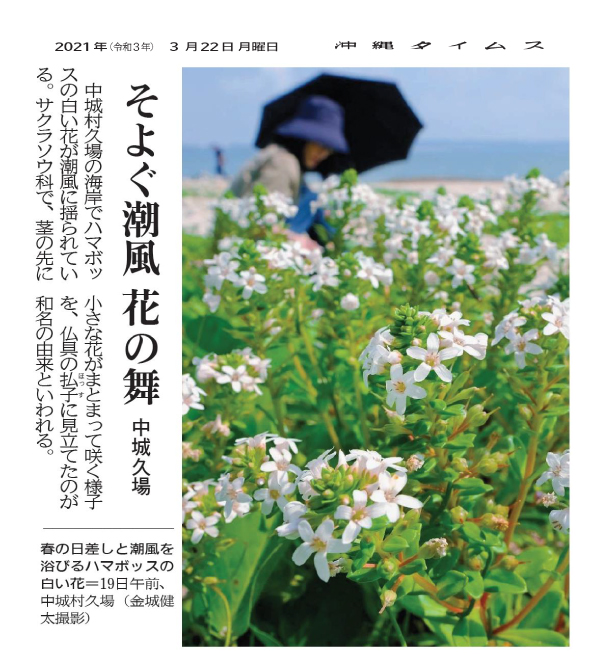
Photo 12: Flowers dancing in the gentle sea breeze 3/22/2021(Courtesy of Okinawa Times)
Flowers Dancing in the Gentle Sea Breeze
Kuba, Nakagusuku Village
White Hamabossu flowers (Lysimachia mauritiana) are swaying in the sea breeze on the coast of Kuba, Nakagusuku Village. These flowers are a member of the primrose family, and its Japanese name is said to have originated from the way the small flowers bloom in clusters at the tip of the stem, which resembles a hossu, a Buddhist altarpiece.
White Hamabossu flowers are blooming in the spring sunshine and sea breeze.
The morning of March 19, Kuba, Nakagusuku Village (Photo by Kenta Kinjo)
3/22/2021(Courtesy of Okinawa Times)
----------------------------------------------------------------------------------------
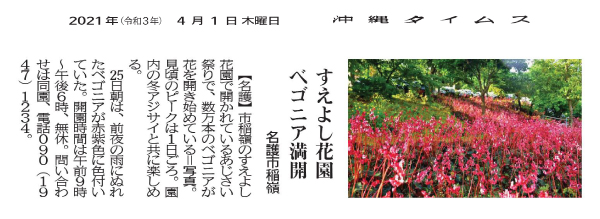
Photo 13: Begonia in full bloom at the Sueyoshi Flower Garden 4/1/2021
(Courtesy of Okinawa Times)
Begonias in full bloom at the Sueyoshi Flower Garden
Tens of thousands of begonias are beginning to bloom at the Hydrangea Festival held at Sueyoshi Flower Garden in Inamine, Nago City. The peak blooming time is around the 1st , and they can be enjoyed them along with the winter hydrangeas in the park.
On the morning of the 25th, the begonias, wet from the rain the night before, were purplish red. The garden is open from 9am to 6 pm, seven days a week.
For more information, call the park at 090 (1947)1234
4/1/2021 (Courtesy of Okinawa Times)
----------------------------------------------------------------------------------------
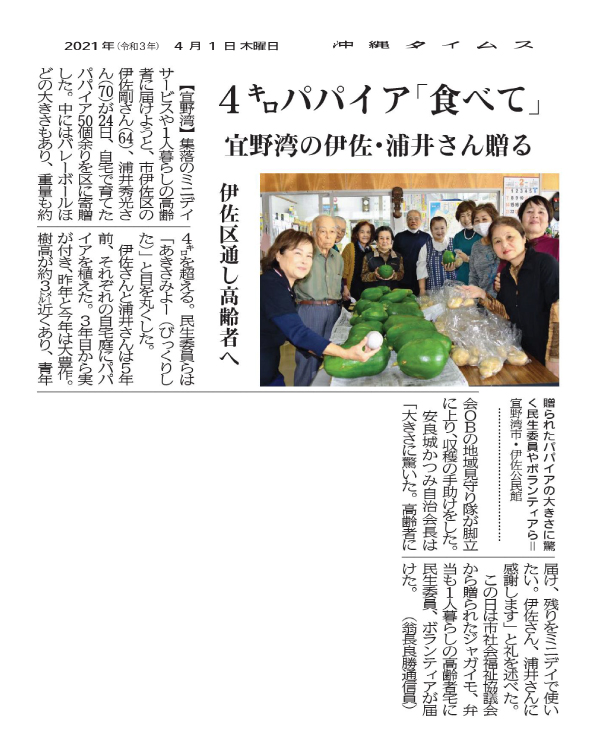
Photo 14: 4 kilogram papayas--“Please have some!” 4/1/2021 (Courtesy of Okinawa Times)
4 kilogram papayas--“Please have some!”
Presented by Mr. Urai, in Isa-ku, Ginowan City
to the seniors in Isa-ku
Mr. Tsuyoshi Isa, 64, and Mr. Hidemitsu Urai, 70, of Isa-ku, Ginowan City, donated more than fifty papayas that they grew at home to Isa-ku, in order that they be delivered to a mini-day service center in their village and to seniors living alone. Some of them are as big as volleyballs and weigh more than four kilograms. The residents’ committee members rolled their eyes, saying, “Akisamiyo,” which means “I’m so surprised,” in Ryukyu dialect.
Mr. Isa and Mr. Urai planted papayas in their own gardens five years ago. The trees have been bearing fruit since the third year, and last year and this year they had a great harvest. The trees are nearly three meters tall, and the community watch team, who are alumni of the youth association, climbed a stepladder to help with the harvest. They thanked Mr. Isa and Mr. Urai, saying they would like to deliver them to seniors first and then use the rest for the mini-day service.
On the same day, volunteers and members of the welfare committee also delivered potatoes and lunch boxes donated by the City Council of Social Welfare to the homes of elderly people living alone. (Reported by Yoshikatsu Onaga)
Volunteers and members of the welfare committee at the Isa Community Center, Ginowan City were surprised at the size of the papayas presented to them.
4/1/2021 (Courtesy of Okinawa Times)
----------------------------------------------------------------------------------------
※ This column describes the possibilities of EM technology during the state of emergency from the perspective of Professor Higa as an academic.
(April 14, 2021)
Editor’s Picks
-

#196 The Steadily Evolving EM Nature Farming Method at the Blue Sky Palace - Part 6 -

#195 The Steadily Evolving EM Nature Farming Method at the Blue Sky Palace - Part 5 -
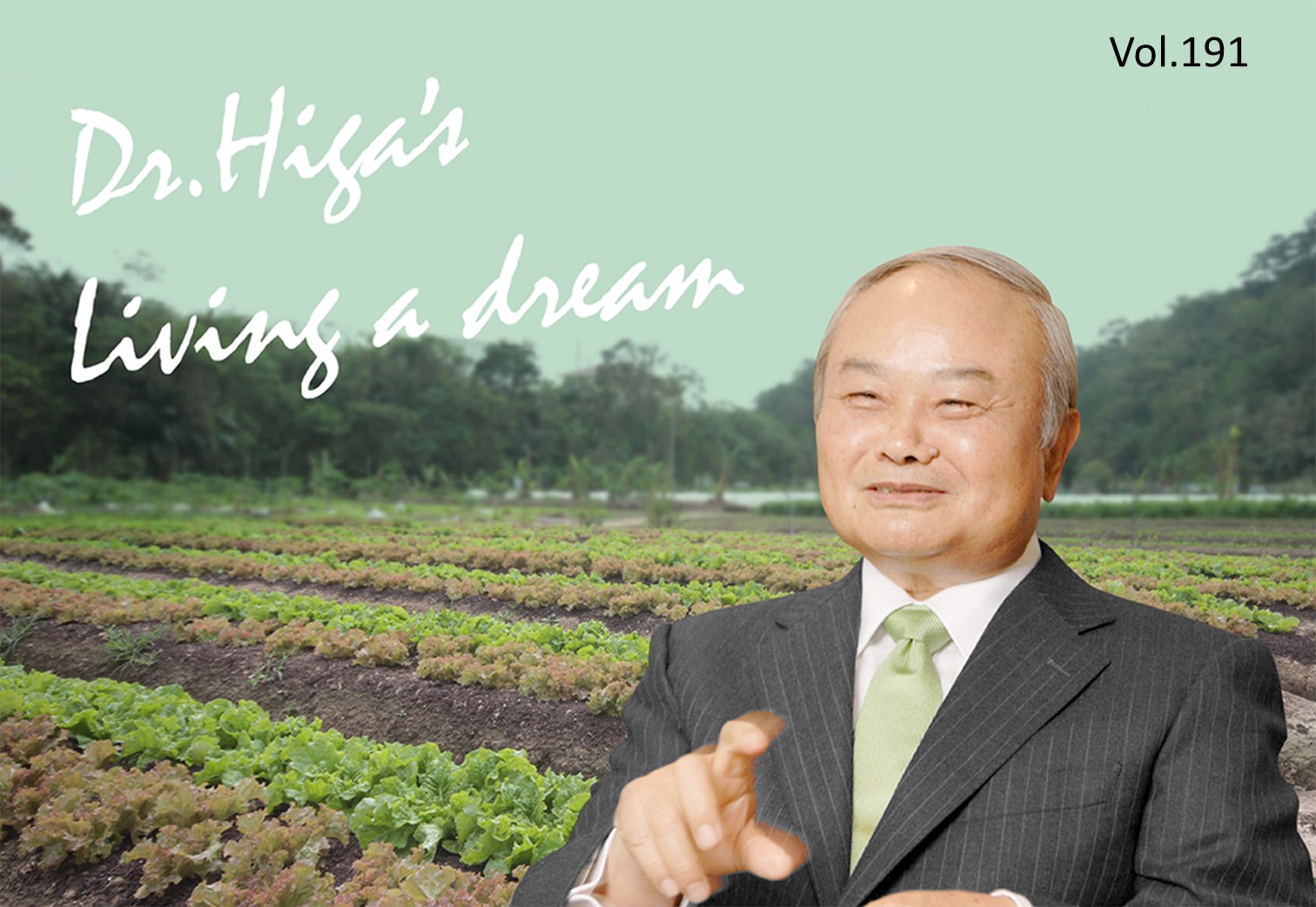
#191 Steadily Evolving EM Nature Farming Method at the Blue Sky Palace -
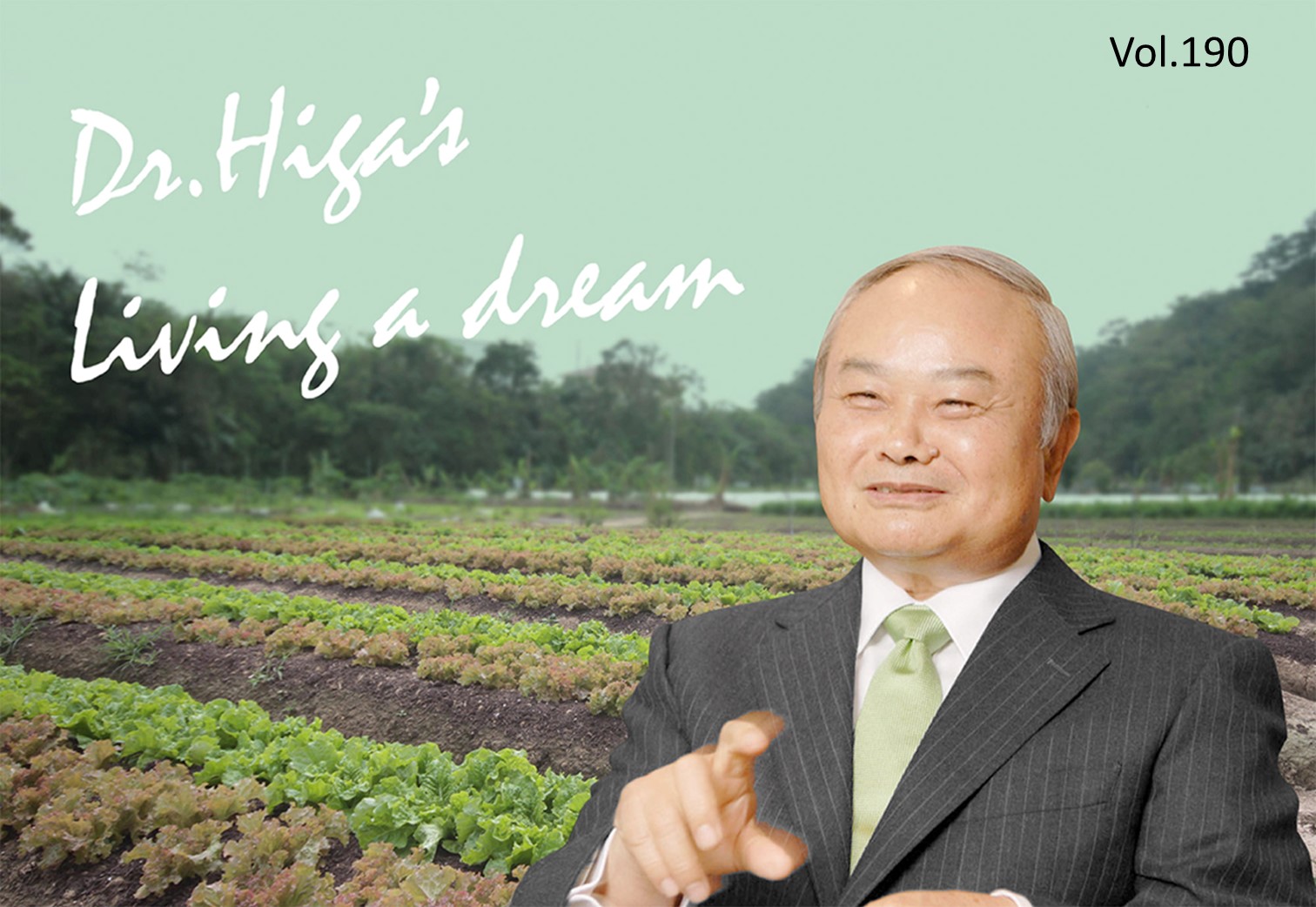
#190 Quantum Mechanical Effects of EM Gravitron Charcoal
- 2025
- Sep:#209 The Widespread Use of EM in Ecuador
- Sep:#208 The Widespread Use of EM in Chile
- Jul:#207 Peru, where EM has taken root throughout the country
- May:#206 EM Application Technology in Paraguay Begins to Evolve into Advanced Circular Agriculture
- May:#205 Practical Application of Soil Disinfectant-Free Cultivation Using EM Technology
- Apr:#204 How EM Use Has Spread Throughout the Philippines
- Mar:#203 How to Use EM to Fundamentally Solve the Problem of Agricultural Residue Burning
- Feb:#202 The Spread of EM technology in Germany
- Jan:#201 The 2nd Ichiro Masaki Memorial Universal Village EM International Conference
- Jan:#200 Cleanup of the Ala Wai Canal in Hawaii, where social bonds are strengthened using EM
- 2024
- Nov:#199 EM trials in India with bananas, tomatoes, and pomegranates
- Oct:#198 The Steadily Evolving EM Nature Farming Method at the Blue Sky Palace - Part 8
- Sep:#197 The Steadily Evolving EM Nature Farming Method at the Blue Sky Palace - Part 7
- Aug:#196 The Steadily Evolving EM Nature Farming Method at the Blue Sky Palace - Part 6
- Jul:#195 The Steadily Evolving EM Nature Farming Method at the Blue Sky Palace - Part 5
- Jun:#194 Steadily Evolving EM Nature Farming Method at the Blue Sky Palace - Part 4
- May:#193 Steadily Evolving EM Nature Farming Method at the Blue Sky Palace - Part 3
- May:#192 Steadily Evolving EM Nature Farming Method at the Blue Sky Palace - Part 2
- Apr:#191 Steadily Evolving EM Nature Farming Method at the Blue Sky Palace
- Mar:#190 Quantum Mechanical Effects of EM Gravitron Charcoal
- Mar:#189 The barrier space in Okinawa (Ryukyu Islands) has risen to another dimension
- Jan:#188 Sixty Days after Typhoon No.6
- 2023
- Oct:#187 Supermassive Typhoon No.6 and Subsequent Typhoon No. 11
- Sep:#186 Massive Typhoon No.6 that swallowed the Ryukyu Islands Graviton barrier
- Sep:#185 August 8th is World “EM Mudball Day”
- Aug:#184 A disease-free life depends on the health of the intestinal microbiome.
- Jul:#183 Trial and Error at the Blue-Sky Palace, Part 3
- Jun:#182 Trial and Error at the Blue-Sky Palace, Part 2
- Apr:#181 Trial and Error at the Blue-Sky Palace
- Mar:#180 Ala Wai Canal Cleanup Project in Waikiki, Hawaii
- Feb:#179 High-Yield, High-Quality Rice Production Using EM
- Feb:#178 The Progress the "Soil Preparation Workshop" of the Oishi 3-chan Club (Part 2)
- Jan:#177 Organic Farming Instructional Manual Using EM
- 2022
- Nov:#176 The Typhoon Situation in Okinawa in 2022
- Sep:#175 Third-Party Verification of the Graviton barrier in Okinawa Part-2
- Sep:#174 Third-Party Verification of the Graviton barrier in Okinawa
- Aug:#173 Ecosystem Changes Observed in Okinawa in 2021 Part-5
- Jun:#172 Ecosystem Changes Observed in Okinawa in 2021 Part-4
- May:#171 Ecosystem Changes Observed in Okinawa in 2021 Part-3
- Apr:#170 Ecosystem Changes Observed in Okinawa in 2021 Part-2
- Mar:#169 Koizumi Farm in Kamakura Continues to Evolve
- Feb:#168 Ecosystem Changes Observed in Okinawa in 2021 Part-1
- 2021
- Dec:#167 Enjoying EM Technology While Enriching the Local Ecosystem
- Nov:#166 A Case Study of the Use of EM in a Next Generation Free School in Tune with the Cycles of Nature
- Oct:#165 Typhoon conditions and flowers in Okinawa from August to October
- Sep:#164 Re-learning the origins of river purification using EM Cleaning up the Dairyuji River in Senami (Murakami City, Niigata Prefecture)
- Aug:#163 Measures Against Natural Disasters and Re-learning the Starting Point of EM
- Jul:#162 Summary of FFC (Foods for Children) Okinawa Forum 2021
- Jun:#161 Restoring the Vigor of an Old Tree and Purifying the Environment with EM Technology That Even an Amateur Can Do
- May:#160 The Public is Beginning to Recognize the Use of EM Smokeless Carbonizers
- Apr:#159 EM Hado (EM Graviton) that exerts quantum superposition effect over time
- Mar:#158 Virus-free Okinawan Plants Through Use of an EM Graviton Barrier
- Jan:#157 Enjoyable Farming for Self-Sufficiency that Even Amateurs Can Do
- 2020
- Dec:#156 EM quantum energy effect occurring in Okinawa
- Nov:#155 Implementing EM graviton farming as a flood countermeasure for apple orchards
- Oct:#154 The Latest Book on the Practical Uses of EM "You Are the One Who Draws Out the Power of Microorganisms," by Chizuko Nomoto
- Sep:#153 Application of EM technology to long periods of rain, lack of sunshine, storms, heavy rains, etc.
- Aug:#152 EM application in Kitanakagusuku village plant waste recycling yard
- Jul:#151 Natural Disaster Countermeasures Using EM Technology: Part 2
- Jul:#150 Natural Disaster Countermeasures Using EM Technology
- May:#149 How to make your home and workplace an energy spot by living a complete EM lifestyle: creating the ultimate source of health and environmental purification
- Apr:#148 EM, Viruses and the Pandemic
- Apr:#147 New agriculture applying quantum mechanics Part 2
- Apr:#146 New agriculture applying quantum mechanics
- Apr:#145 Wonderful EM Miracle
- 2019
- Nov:#144 The movie “Revival II” and the reality of Fukushima
- Oct:#143 Boundary dome and foliar spraying of EM・X GOLD and EM 3
- Oct:#142 Kirakira (Sparkling) Summer Vegetable Festa in 2019
- Aug:#141 Excessive salt inevitably causes salt damage
- Jul:#140 Diverse applications of charcoal Part 3
- Jun:#139 Diverse applications of charcoal Part 2
- Jun:#138 Diverse applications of charcoal
- Jun:#137 Purification power of salt
- May:#136 The degree of soil contamination is a reflection of the microflora
- May:#135 Definitive use of EM barriers to deal with typhoons
- May:#134 Implementing authentic Nature Farming
- May:#133 How to enhance healthy Hado (wave energy) by EM
- May:#132 Eating Dirt (Soil)
- May:#131 Hado (Wave energy) involved in health
- May:#130 Reaffirming EM technology to realize the essence of agriculture
- May:#129 The 2nd EM Producer Networking Meeting
- Apr:#128 Understanding the application of seawater and salt in crop cultivation
- Apr:#127 Prevention of Disasters by EM Technology
- Mar:#126 Quantum overlay effective utilization of EM
- Jan:#125 EM Disaster Recovery Support Projects in 2017
- 2018
- 2017
- Aug:#121 Escape from conventional agricultural traps
- Jul:#120 Limitation and important caveats regarding utilization of salt
- Jun:#119 EM Technology to Break Through the Limits of Pesticide-Free Strawberries
- May:#118 Application of barriers using EM rectification force
- Apr:#117 The 1st EM Produce Growers' Networking Conference
- Mar:#116 Sumizo kun: The Ultimate Versatile Carbonization Equipment
- Feb:#115 How to make and use simple carbonized and rectified ash
- Jan:#114 Achievements of 2016
- 2016
- Dec:#113 Definitive Measures Against Typhoons
- Nov:#112 International Conference on Universal Village
- Oct:#111 90% of Your Body is Microbes
- Sep:#110 Disaster Countermeasures Using EM
- Aug:#109: Changes in the Natural Environment by EM Barrier Domes in Okinawa
- Jul:#108: Multi-purpose Utilization of Activated EM with Seawater and Salt
- Jun:#107: Marine Day, when EM Mudballs and Activated EM are Applied Throughout Japan
- May:#106: The Function of EM and Gravitational Waves–Part 3
- Apr:#105: The Function of EM and Gravitational Waves–Part 2
- Feb:#104: The Function of EM and Gravitational Waves
- Feb:#103: The Importance of Phototrophic Bacteria in EM
- 2015
- Dec:#102: Results of Environmental Forum "Utsukushima EM Paradise" 2015
- Nov:#101: Environmental Forum "Utsukushima EM Paradise" 2015
- Oct:#100: A New Phase of Limit Breakthrough Using EM
- Sep:#99: A New Phase of Limit Breakthrough through EM
- Aug:#98: The Tokyo Bay Area Began Creating a Truly Livable Hometown
- Jul:#97: Rectifying Effects of EM
- Jun:#96: Lake Suwa Sousei lecture
- May:#95: In Order to Further Ensure Limit Breakthrough
- Apr:#94: Theatrical Release of the Documentary Film SOSEI-Revival to Enlighten People on the New Possibilities of Microorganisms
- Mar:#93: What Underlies Limit Breakthrough (Part 2)
- Feb:#92: EM Functions to Break Through Limits
- Jan:#91: At the Start of 2015
- 2014
- Dec:#90: Looking Back at 2014
- Nov:#89: Shikoku EM FESTA 2014, Virtuous Circle Conference in Matsuyama, Ehime Prefecture
- Oct:#88: Using EM to Deal with Weather Disasters (Part 2)
- Sep:#87: Current Status of Radioactivity Measures Using EM in Fukushima
- Aug:#86: APNAN (Asia Pacific Natural Agriculture Network) 25th Anniversary Conference in 2014
- Jul:#85: Using EM to Deal with Weather Disasters
- Jun:#84: Substantial Improvement of Soil
- May:#83: The Energy Rectification Force of EM
- Apr:#82: The Annual 18th EM Technology Exchange Meeting and Tohoku Conference in Shichigahama
- Mar:#81: Salmon going upstream in Kitaura (Kasumigaura)
- Feb:#80: The Microbiome Again
- Jan:#79: Inauguration of the Federation of Diet Members Who Use and Apply Effective Microorganisms
- 2013
- Dec:#78: Receiving an Honorary Doctoral Degree from Rajamangala University of Technology in Thailand
- Nov:#77: The Use of EM in School Education in Bhutan
- Oct:#76: Well of Bonding
- Sep:#75: The Background to EM Not Being Employed by Public Institutions to Deal with Radiation
- Aug:#74: Dealing with Disaster: Using EM in Crisis Management
- Jul:#73: EM Events on Ocean Day
- Jun:#72: Using EM to Deal With Heat Stroke and Summer Heat Fatigue
- May:#71: An EM Model Town in Malaysia
- Apr:#70: Steps the Japanese Government is Taking to Deal with Radiation: Are They Really Safe?
- Mar:#69: EM Group Disaster Reconstruction Aid Project in Fukushima
- Feb:#68: EM and Microbiomes (Microbial Flora)
- Jan:#67: A Necessary Evil is Still Evil
- 2012
- Dec:#66: The 17th National EM Technology Exchange Conference / Hokkaido Conference in Sapporo
- Nov:#65: EM Forum 2012 in Okinawa and the Environmental Forum in Fukushima
- Oct:#64: 2012 EM Forum
- Sep:#63: A New Earth Saving Revolution
- Aug:#62: The Asahi Newspaper’s Misguided Reports About EM
- Jul:#61: Using EM in Radioactive Contamination Measures in Fukushima Prefecture
- Jun:#60: The Effects of Using EM to Inhibit the Absorption of Radioactivity as Confirmed in Fukushima
- May:#59: Recovery Support for the Great East Japan Earthquake
- Apr:#58: The Royal Kingdom of Thailand, in which EM Functions as a Set Government Policy
- Mar:#57: Report on the Measures Taken by Kingdom of Thailand Using EM to Deal with Polluted Water
- Feb:#56 EM™ as Part of National Policy in Thailand to Deal with Sanitation Issues Resulting from the Flood of 2011
- Jan:#55 The Law of Syntropy (Revitalization)
- 2011
- Dec:#54 EM Forum 2011
- Nov:#53 Shikoku EM Festa 2011- Zenjunkan no Wa (Virtuous Circle) Tokushima Conference in Naruto -
- Oct:#52 The Mystery of Interim Safety Values for Radioactive Material
- Sep:#51 Successful Radiation Countermeasures Using EM
- Aug:#50 Events on Sea Day in which EM Mud Balls are Thrown into the Water and Activated EM is Applied.
- May:#47 Dealing with the Damage Caused by the Eastern Japan Earthquake
- Apr:#46 Eastern Japan Earthquake
- Mar:#45 The 16th National EM Technology Hokuriku Conference in Fukui
- Feb:#44 More Thoughts on Avian Influenza and Foot-and-Mouth Disease
- Jan:#43 Happy New Year!
- 2010
- Dec:#42 Shikoku EM FESTA 2010・Zenjunkan no wa (Virtuous Circle) Fellowship Conference in Tobe, Ehime Prefecture
- Nov:#41 EM Forum 2010
- Oct:#40: My Thanks to the EM™ Volunteers Who Helped in the Fight Against Foot-and-Mouth Disease in Miyazaki Prefecture
- Sep:#39 International EM Mud Ball Day
- Jul:#37 Poland EM Forum 2010
- Jun:#36 EM Countermeasures Against Foot-and-Mouth Disease
- May:#35 Abnormal Weather
- Apr:#34 EM Activities in Thailand: Finding Solutions to the Challenges Facing the Nation
- Mar:#33 New Developments in the Evolution of EMTM in Thailand
- Feb:#32 Results Starting to Be Seen at the Mikasa Project
- Jan:#31 Towards an EM-Use Society
- 2009
- Dec:#30 EM Summit
- Nov:#29 The System in Penang State in Malaysia that Made the World EMTM Mudball Day a Success
- Oct:#28 The "World EM Mudball Day" in Malaysia
- Sep:#27 Validating EMTM Medicine: Case Study Reports from EM Users 2009. (Part 3)
- Sep:#26 Validating EMTM Medicine: Case Study Reports from EMTM Users 2009. (Part 2)
- Jul:#25 Validating EMTM Medicine: Case Study Reports from EMTM Users 2009. (Part 1)
- Jun:#24 Activities to Disseminate EM-Focused Nature Farming in China
- May:#23 Use of EMTM in Response to Swine Flu
- Apr:#22 Using EM to Solve Public Administrative Costs
- Mar:#21 Reaffirming the Versatility of EM
- Jan:#20 The Beginning of a New Era
- 2008
